Assessment of Soil Wind Erosion and Population Exposure Risk in Central Asia’s Terminal Lake Basins
Abstract
1. Introduction
2. Materials and Methods
2.1. Study Area
2.2. Data Resources
2.2.1. Meteorological Data
2.2.2. Population Grid Data
2.2.3. Vegetation Data
2.2.4. Soil Data
2.2.5. Land-Use and Land-Cover (LULC) Data
2.2.6. Other Data
2.3. RWEQ Model
2.3.1. Weather Factor ()
2.3.2. Soil Erodibility Factor ()
2.3.3. Soil Crust Factor ()
2.3.4. Soil Roughness Factor ()
2.3.5. Vegetation Factor ()
2.4. PER Model
2.5. HYSPLIT Model
2.6. Trend Analysis
2.7. Correlation Analysis
3. Results
3.1. Spatial Variation of SWE
3.2. Temporal Variation of SWE
3.3. Dust Movement Trajectories
3.4. PER to SWE
4. Discussion
4.1. Response of PM2.5 and SWE
4.2. Changes in SWE under Different Land-Use/Cover Changes (LUCCs)
4.3. Relationship between SWE and Controlling Climatic and Vegetation Factors
5. Conclusions
Author Contributions
Funding
Data Availability Statement
Conflicts of Interest
References
- Xu, H.; Wang, Y.; Han, T.; Li, R.; Ma, J.; Qiu, X.; Ying, L.; Zheng, H. Enhanced assessment of regional impacts from wind erosion by integrating particle size. Catena 2024, 239, 107937. [Google Scholar] [CrossRef]
- Motameni, S.; Soroush, A.; Fattahi, S.M.; Eslami, A. A data-driven approach for assessing the wind-induced erodible fractions of soil. J. Arid. Environ. 2024, 222, 105152. [Google Scholar] [CrossRef]
- Zhang, H.; Peng, J.; Zhao, C. Wind speed and vegetation coverage in turn dominated wind erosion change with increasing aridity in Africa. Earth’s Future 2024, 12, e2024EF004468. [Google Scholar] [CrossRef]
- Zou, X.; Li, J.; Cheng, H.; Wang, J.; Zhang, C.; Kang, L.; Liu, W.; Zhang, F. Spatial variation of topsoil features in soil wind erosion areas of northern China. Catena 2018, 167, 429–439. [Google Scholar] [CrossRef]
- Yan, H.; Wang, S.; Wang, C.; Zhang, G.; Patel, N. Losses of soil organic carbon under wind erosion in China. Glob. Chang. Biol. 2005, 11, 828–840. [Google Scholar] [CrossRef]
- Zachar, D. Soil Erosion; Elsevier Scientific Publishing Company: Amsterdam, The Netherlands; Oxford, UK; New York, NY, USA, 1982. [Google Scholar] [CrossRef]
- Chen, L.; Zhao, H.; Han, B.; Bai, Z. Combined use of WEPS and Models-3/CMAQ for simulating wind erosion source emission and its environmental impact. Sci. Total Environ. 2014, 466, 762–769. [Google Scholar] [CrossRef] [PubMed]
- Mirzabaev, A.; Strokov, A.; Krasilnikov, P. The impact of land degradation on agricultural profits and implications for poverty reduction in Central Asia. Land Use Policy 2023, 126, 106530. [Google Scholar] [CrossRef]
- Treminio, R.S.; Webb, N.P.; Edwards, B.L.; Faist, A.; Newingham, B.; Kachergis, E. Spatial patterns and controls on wind erosion in the Great Basin. J. Geophys. Res. Biogeosci. 2024, 129, e2023JG007792. [Google Scholar] [CrossRef]
- Duniway, M.C.; Pfennigwerth, A.A.; Fick, S.E.; Nauman, T.W.; Belnap, J.; Barger, N.N. Wind erosion and dust from US drylands: A review of causes, consequences, and solutions in a changing world. Ecosphere 2019, 10, e02650. [Google Scholar] [CrossRef]
- Goudarzi, G.; Shirmardi, M.; Naimabadi, A.; Ghadiri, A.; Sajedifar, J. Chemical and organic characteristics of PM2. 5 particles and their in-vitro cytotoxic effects on lung cells: The Middle East dust storms in Ahvaz, Iran. Sci. Total Environ. 2019, 655, 434–445. [Google Scholar] [CrossRef]
- Marzen, M.; Iserloh, T.; Fister, W.; Seeger, M.; Rodrigo-Comino, J.; Ries, J.B. On-site water and wind erosion experiments reveal relative impact on total soil erosion. Geosciences 2019, 9, 478. [Google Scholar] [CrossRef]
- Sirjani, E.; Sameni, A.; Mahmoodabadi, M.; Moosavi, A.A.; Laurent, B. In-situ wind tunnel experiments to investigate soil erodibility, soil fractionation and wind-blown sediment of semi-arid and arid calcareous soils. Catena 2024, 241, 108011. [Google Scholar] [CrossRef]
- Chen, J.; Feng, R.; Li, D.; Yuan, Z. Revealing soil erosion and sediment sources using 137Cs and fingerprinting in an agroforestry catchment. Soil. Tillage Res. 2024, 235, 105919. [Google Scholar] [CrossRef]
- Pi, H.; Sharratt, B. Evaluation of the RWEQ and SWEEP in simulating soil and PM10 loss from a portable wind tunnel. Soil. Tillage Res. 2017, 170, 94–103. [Google Scholar] [CrossRef]
- Woodruff, N.P.; Siddoway, F. A wind erosion equation. Soil. Sci. Soc. Am. J. 1965, 29, 602–608. [Google Scholar] [CrossRef]
- Fryrear, D.; Bilbro, J.; Saleh, A.; Schomberg, H.; Stout, J.; Zobeck, T. RWEQ: Improved wind erosion technology. J. Soil. Water Conserv. 2000, 55, 183–189. [Google Scholar]
- Hagen, L.J. Evaluation of the Wind Erosion Prediction System (WEPS) erosion submodel on cropland fields. Environ. Model. Softw. 2004, 19, 171–176. [Google Scholar] [CrossRef]
- Gregory, J.M.; Wilson, G.R.; Singh, U.B.; Darwish, M.M. TEAM: Integrated, process-based wind-erosion model. Environ. Model. Softw. 2004, 19, 205–215. [Google Scholar] [CrossRef]
- Van Pelt, R.S.; Zobeck, T.M.; Potter, K.N.; Stout, J.E.; Popham, T. Validation of the wind erosion stochastic simulator (WESS) and the revised wind erosion equation (RWEQ) for single events. Environ. Model. Softw. 2004, 19, 191–198. [Google Scholar] [CrossRef]
- Liao, J.; Peng, F.; Kang, W.; Chen, X.; Sun, J.; Chen, B.; Xia, Y.; Du, H.; Li, S.; Song, X.; et al. No increase of soil wind erosion with the establishment of center pivot irrigation system in Mu-Us sandy land. Sci. Total Environ. 2024, 939, 173558. [Google Scholar] [CrossRef]
- Ma, X.; Zhao, C.; Zhu, J. Aggravated risk of soil erosion with global warming–A global meta-analysis. Catena 2021, 200, 105129. [Google Scholar] [CrossRef]
- Duan, W.; Zou, S.; Chen, Y.; Nover, D.; Fang, G.; Wang, Y. Sustainable water management for cross-border resources: The Balkhash Lake Basin of Central Asia, 1931–2015. J. Clean. Prod. 2020, 263, 121614. [Google Scholar] [CrossRef]
- Wang, J.; Yang, S.; Lou, H.; Liu, H.; Wang, P.; Li, C.; Zhang, F. Impact of lake water level decline on river evolution in Ebinur Lake Basin (an ungauged terminal lake basin). Int. J. Appl. Earth Obs. Geoinf. 2021, 104, 102546. [Google Scholar] [CrossRef]
- Bolgov, M.; Kashnitskaya, M.; Zaitseva, A.; Pozdnyakov, S.; Ping, W. Long-Term Water Level Fluctuations in Terminal Lakes of Central Asia. Geogr. Nat. Resour. 2022, 43, S15–S21. [Google Scholar] [CrossRef]
- Deng, H.; Flörke, M.; Lei, K.; Tang, Q. Estimating Multi-sectoral Water Withdrawals Through Machine Learning for Attribution in an Ungauged Terminal Lake Basin in Central Asia. In Proceedings of the EGU General Assembly 2024, Vienna, Austria, 14–19 April 2024. Copernicus Meetings, 2024. [Google Scholar]
- Dou, X.; Ma, X.; Huo, T.; Zhu, J.; Zhao, C. Assessment of the environmental effects of ecological water conveyance over 31 years for a terminal lake in Central Asia. Catena 2022, 208, 105725. [Google Scholar] [CrossRef]
- Petr, T.; Mitrofanov, V.P. The impact on fish stocks of river regulation in Central Asia and Kazakhstan. Lakes Reserv. Res. Manag. 1998, 3, 143–164. [Google Scholar] [CrossRef]
- He, J.; Yu, Y.; Sun, L.; Li, C.; Zhang, H.; Malik, I.; Wistuba, M.; Yu, R. Spatiotemporal variations of ecosystem services in the Aral Sea basin under different CMIP6 projections. Sci. Rep. 2024, 14, 12237. [Google Scholar] [CrossRef] [PubMed]
- Indoitu, R.; Kozhoridze, G.; Batyrbaeva, M.; Vitkovskaya, I.; Orlovsky, N.; Blumberg, D.; Orlovsky, L. Dust emission and environmental changes in the dried bottom of the Aral Sea. Aeolian Res. 2015, 17, 101–115. [Google Scholar] [CrossRef]
- Wang, W.; Samat, A.; Abuduwaili, J.; Ge, Y.; De Maeyer, P.; Van de Voorde, T. Temporal characterization of sand and dust storm activity and its climatic and terrestrial drivers in the Aral Sea region. Atmos. Res. 2022, 275, 106242. [Google Scholar] [CrossRef]
- Breckle, S.-W.; Wucherer, W. The Aralkum, a man-made desert on the desiccated floor of the Aral Sea (Central Asia): Final conclusions and comments. In Aralkum—A Man-Made Desert: The Desiccated Floor of the Aral Sea (Central Asia); Springer: Berlin/Heidelberg, Germany, 2012; pp. 459–464. [Google Scholar] [CrossRef]
- Khudaybergenov, U.; Abbosov, S.A.; Ollayarov, A. Early Diagnosis and Prevention of Urolithiasis in the Aral Sea Regions. Galaxy Int. Interdiscip. Res. J. 2024, 12, 115–119. [Google Scholar]
- Goudie, A.S. Desert dust and human health disorders. Environ. Int. 2014, 63, 101–113. [Google Scholar] [CrossRef]
- Tuholske, C.; Caylor, K.; Funk, C.; Verdin, A.; Sweeney, S.; Grace, K.; Peterson, P.; Evans, T. Global urban population exposure to extreme heat. Proc. Natl. Acad. Sci. USA 2021, 118, e2024792118. [Google Scholar] [CrossRef]
- Sheldon, L.S.; Cohen Hubal, E.A. Exposure as part of a systems approach for assessing risk. Environ. Health Perspect. 2009, 117, 1181–1194. [Google Scholar] [CrossRef]
- Zhao, C.; Pan, J.; Zhang, L. Spatio-temporal patterns of global population exposure risk of PM2. 5 from 2000–2016. Sustainability 2021, 13, 7427. [Google Scholar] [CrossRef]
- Peduzzi, P.; Dao, H.; Herold, C.; Mouton, F. Assessing global exposure and vulnerability towards natural hazards: The Disaster Risk Index. Nat. Hazards Earth Syst. Sci. 2009, 9, 1149–1159. [Google Scholar] [CrossRef]
- Wang, G.; Yuan, X.; Jing, C.; Hamdi, R.; Ochege, F.U.; Dong, P.; Shao, Y.; Qin, X. The decreased cloud cover dominated the rapid spring temperature rise in arid Central Asia over the period 1980–2014. Geophys. Res. Lett. 2024, 51, e2023GL107523. [Google Scholar] [CrossRef]
- Bai, J.; Chen, X.; Li, J.; Yang, L.; Fang, H. Changes in the area of inland lakes in arid regions of central Asia during the past 30 years. Environ. Monit. Assess. 2011, 178, 247–256. [Google Scholar] [CrossRef]
- Deng, H.; Chen, Y. Influences of recent climate change and human activities on water storage variations in Central Asia. J. Hydrol. 2017, 544, 46–57. [Google Scholar] [CrossRef]
- Jin, C.; Wang, B.; Cheng, T.F.; Dai, L.; Wang, T. How much we know about precipitation climatology over Tianshan Mountains––the Central Asian water tower. npj Clim. Atmos. Sci. 2024, 7, 21. [Google Scholar] [CrossRef]
- Yang, T.; Chen, X.; Hamdi, R.; Li, Q.; Cui, F.; Li, L.; Liu, Y.; De Maeyer, P.; Duan, W. Assessment of snow simulation using Noah-MP land surface model forced by various precipitation sources in the Central Tianshan Mountains, Central Asia. Atmos. Res. 2024, 300, 107251. [Google Scholar] [CrossRef]
- Tian, R.; Liu, L.; Zheng, J.; Li, J.; Han, W.; Liu, Y. Combined Effects of Meteorological Factors, Terrain, and Greenhouse Gases on Vegetation Phenology in Arid Areas of Central Asia from 1982 to 2021. Land 2024, 13, 180. [Google Scholar] [CrossRef]
- Mishra, K.; Choudhary, B.; Fitzsimmons, K.E. Predicting and evaluating seasonal water turbidity in Lake Balkhash, Kazakhstan, using remote sensing and GIS. Front. Environ. Sci. 2024, 12, 1371759. [Google Scholar] [CrossRef]
- Li, W.; Hao, X.; Chen, Y.; Zhang, L.; Ma, X.; Zhou, H. Response of groundwater chemical characteristics to ecological water conveyance in the lower reaches of the Tarim River, Xinjiang, China. Hydrol. Process. Int. J. 2010, 24, 187–195. [Google Scholar] [CrossRef]
- Bao, A.; Yu, T.; Xu, W.; Lei, J.; Jiapaer, G.; Chen, X.; Komiljon, T.; Khabibullo, S.; Sagidullaevich, X.B.; Kamalatdin, I. Ecological problems and ecological restoration zoning of the Aral Sea. J. Arid. Land 2024, 16, 315–330. [Google Scholar] [CrossRef]
- Liu, S.; Long, A.; Yan, D.; Luo, G.; Wang, H. Predicting Ili River streamflow change and identifying the major drivers with a novel hybrid model. J. Hydrol. Reg. Stud. 2024, 53, 101807. [Google Scholar] [CrossRef]
- Zou, S.; Jilili, A.; Duan, W.; Maeyer, P.D.; de Voorde, T.V. Human and natural impacts on the water resources in the Syr Darya River Basin, Central Asia. Sustainability 2019, 11, 3084. [Google Scholar] [CrossRef]
- Zan, C.; Liu, T.; Huang, Y.; Bao, A.; Yan, Y.; Ling, Y.; Wang, Z.; Duan, Y. Spatial and temporal variation and driving factors of wetland in the Amu Darya River Delta, Central Asia. Ecol. Indic. 2022, 139, 108898. [Google Scholar] [CrossRef]
- Feng, M.; Chen, Y.; Li, Z.; Duan, W.; Zhu, Z.; Liu, Y.; Zhou, Y. Optimisation model for sustainable agricultural development based on water-energy-food nexus and CO2 emissions: A case study in Tarim river basin. Energy Convers. Manag. 2024, 303, 118174. [Google Scholar] [CrossRef]
- Yapiyev, V.; Sagintayev, Z.; Inglezakis, V.J.; Samarkhanov, K.; Verhoef, A. Essentials of endorheic basins and lakes: A review in the context of current and future water resource management and mitigation activities in Central Asia. Water 2017, 9, 798. [Google Scholar] [CrossRef]
- Bai, J.; Chen, X.; Yang, L.; Fang, H. Monitoring variations of inland lakes in the arid region of Central Asia. Front. Earth Sci. 2012, 6, 147–156. [Google Scholar] [CrossRef]
- Li, J.; Yuan, X.; Su, Y.; Qian, K.; Liu, Y.; Yan, W.; Xu, S.; Yang, X.; Luo, G.; Ma, X. Trade-offs and synergistic relationships in wind erosion in Central Asia over the last 40 years: A Bayesian Network analysis. Geoderma 2023, 437, 116597. [Google Scholar] [CrossRef]
- Yang, Y.; Chen, R.-S.; Ding, Y.-J.; Li, H.-Y.; Liu, Z.-W. Changes in global land surface frozen ground and freeze-thaw processes during 1950–2020 based on ERA5-Land data. Adv. Clim. Chang. Res. 2024, 15, 265–274. [Google Scholar] [CrossRef]
- Wang, Y.-R.; Hessen, D.O.; Samset, B.H.; Stordal, F. Evaluating global and regional land warming trends in the past decades with both MODIS and ERA5-Land land surface temperature data. Remote Sens. Environ. 2022, 280, 113181. [Google Scholar] [CrossRef]
- Lichiheb, N.; Ngan, F.; Cohen, M. Improving the atmospheric dispersion forecasts over Washington, DC using UrbanNet observations: A study with HYSPLIT model. Urban. Clim. 2024, 55, 101948. [Google Scholar] [CrossRef]
- Kimo, I.G.; Cholo, B.E.; Lohani, T.K. Identifying the Moisture Sources in Different Seasons for Abaya-Chamo Basin of Southern Ethiopia Using Lagrangian Particle Dispersion Model. Adv. Meteorol. 2024, 2024, 4421766. [Google Scholar] [CrossRef]
- Ma, J.; Sun, Y.; Meng, D.; Huang, S.; Li, N.; Zhu, H. Accuracy assessment of two global gridded population dataset: A case study in china. In Proceedings of the 4th International Conference on Information Science and Systems, Online, 17–19 March 2021; pp. 120–125. [Google Scholar] [CrossRef]
- Bhaduri, B. Development of high resolution population and social dynamics models and databases. In Proceedings of the 1st International Conference and Exhibition on Computing for Geospatial Research & Application, Bethesda, MD, USA, 21–23 June 2010; p. 1. [Google Scholar] [CrossRef]
- Mohanty, M.P.; Simonovic, S.P. Understanding dynamics of population flood exposure in Canada with multiple high-resolution population datasets. Sci. Total Environ. 2021, 759, 143559. [Google Scholar] [CrossRef]
- Yin, X.; Li, P.; Feng, Z.; Yang, Y.; You, Z.; Xiao, C. Which gridded population data product is better? Evidences from mainland southeast Asia (MSEA). ISPRS Int. J. Geo-Inf. 2021, 10, 681. [Google Scholar] [CrossRef]
- Albarakat, R.; Lakshmi, V. Comparison of normalized difference vegetation index derived from Landsat, MODIS, and AVHRR for the Mesopotamian marshes between 2002 and 2018. Remote Sens. 2019, 11, 1245. [Google Scholar] [CrossRef]
- Wang, S.; Liu, Q.; Huang, C. Vegetation change and its response to climate extremes in the arid region of Northwest China. Remote Sens. 2021, 13, 1230. [Google Scholar] [CrossRef]
- Hao, H.; Chen, Y.; Xu, J.; Li, Z.; Li, Y.; Kayumba, P.M. Water deficit may cause vegetation browning in central Asia. Remote Sens. 2022, 14, 2574. [Google Scholar] [CrossRef]
- Fan, J.; Fan, Y.; Cheng, J.; Wu, H.; Yan, Y.; Zheng, K.; Shi, M.; Yang, Q. The Spatio-Temporal Evolution Characteristics of the Vegetation NDVI in the Northern Slope of the Tianshan Mountains at Different Spatial Scales. Sustainability 2023, 15, 6642. [Google Scholar] [CrossRef]
- Wang, S.; Cui, D.; Wang, L.; Peng, J. Applying deep-learning enhanced fusion methods for improved NDVI reconstruction and long-term vegetation cover study: A case of the Danjiang River Basin. Ecol. Indic. 2023, 155, 111088. [Google Scholar] [CrossRef]
- Xu, S.; Su, Y.; Yan, W.; Liu, Y.; Wang, Y.; Li, J.; Qian, K.; Yang, X.; Ma, X. Influences of Ecological Restoration Programs on Ecosystem Services in Sandy Areas, Northern China. Remote Sens. 2023, 15, 3519. [Google Scholar] [CrossRef]
- Guida, G.; Nicosia, A.; Settanni, L.; Ferro, V. A review on effects of biological soil crusts on hydrological processes. Earth-Sci. Rev. 2023, 243, 104516. [Google Scholar] [CrossRef]
- Chamizo, S.; Rodríguez-Caballero, E.; Cantón, Y.; Asensio, C.; Domingo, F. Penetration resistance of biological soil crusts and its dynamics after crust removal: Relationships with runoff and soil detachment. Catena 2015, 126, 164–172. [Google Scholar] [CrossRef]
- Xu, J.; Xiao, Y.; Xie, G.; Wang, Y.; Jiang, Y. Computing payments for wind erosion prevention service incorporating ecosystem services flow and regional disparity in Yanchi County. Sci. Total Environ. 2019, 674, 563–579. [Google Scholar] [CrossRef]
- Wang, S.; Shi, H.; Xu, X.; Huang, L.; Gu, Q.; Liu, H. County zoning and optimization paths for trade-offs and synergies of ecosystem services in Northeast China. Ecol. Indic. 2024, 164, 112044. [Google Scholar] [CrossRef]
- Huang, D.; Zhang, Y.; Cheng, H.; Andrea, C.; Shi, J.; Chen, C.; Teng, Y.; Zeng, L. Evaluating air pollution exposure among cyclists: Real-time levels of PM2.5 and NO2 and POI impact. Sci. Total Environ. 2024, 945, 173559. [Google Scholar] [CrossRef] [PubMed]
- Stein, A.; Draxler, R.R.; Rolph, G.D.; Stunder, B.J.; Cohen, M.D.; Ngan, F. NOAA’s HYSPLIT atmospheric transport and dispersion modeling system. Bull. Am. Meteorol. Soc. 2015, 96, 2059–2077. [Google Scholar] [CrossRef]
- Qor-el-aine, A.; Beres, A.; Geczi, G. Dust storm simulation over the Sahara Desert (Moroccan and Mauritanian regions) using HYSPLIT. Atmos. Sci. Lett. 2022, 23, e1076. [Google Scholar] [CrossRef]
- Gammoudi, N.; Kovács, J.; Gresina, F.; Varga, G. Combined use of HYSPLIT model and MODIS aerosols optical depth to study the spatiotemporal circulation patterns of Saharan dust events over Central Europe. Aeolian Res. 2024, 67, 100899. [Google Scholar] [CrossRef]
- Alebić-Juretić, A.; Mifka, B.; Kuzmić, J. Airborne desert dust in the Northern Adriatic area (Croatia): Different sources. Sci. Total Environ. 2024, 912, 169320. [Google Scholar] [CrossRef] [PubMed]
- Miao, M.; Zhang, M.; Wang, S.; Sun, Z.; Li, X.; Yuan, X.; Yang, G.; Hu, Z.; Zhang, S. Effect of oasis and irrigation on mountain precipitation in the northern slope of Tianshan Mountains based on stable isotopes. J. Hydrol. 2024, 635, 131151. [Google Scholar] [CrossRef]
- Mao, X.; Xing, L.; Shang, W.; Li, S.; Duan, K. Moisture sources for precipitation over the Pamirs Plateau in winter and spring. Q. J. R. Meteorol. Soc. 2024, 150, 820–833. [Google Scholar] [CrossRef]
- Endale, T.A.; Raba, G.A.; Beketie, K.T.; Feyisa, G.L.; Gebremichael, H.B. Assessment of particulate matter and particle path trajectory analysis using a HYSPLIT model over Dire Dawa, Ethiopia. Discov. Appl. Sci. 2024, 6, 131. [Google Scholar] [CrossRef]
- Hwang, H.; Lee, J.E.; Shin, S.A.; You, C.R.; Shin, S.H.; Park, J.-S.; Lee, J.Y. Vertical Profiles of PM2. 5 and O3 Measured Using an Unmanned Aerial Vehicle (UAV) and Their Relationships with Synoptic-and Local-Scale Air Movements. Remote Sens. 2024, 16, 1581. [Google Scholar] [CrossRef]
- Zhang, S.; Wang, Y.; Zhang, C.; Wu, Y.; Li, C.; Yin, Y. Response mechanism of the thermal environment in the karst rocky desertification areas from the perspective of settlement transition. Urban. Clim. 2024, 55, 101984. [Google Scholar] [CrossRef]
- Tuoku, L.; Wu, Z.; Men, B. Impacts of climate factors and human activities on NDVI change in China. Ecol. Inform. 2024, 81, 102555. [Google Scholar] [CrossRef]
- Panebianco, J.E.; Mendez, M.J.; Buschiazzo, D.E. PM10 emission, sandblasting efficiency and vertical entrainment during successive wind-erosion events: A wind-tunnel approach. Bound.-Layer Meteorol. 2016, 161, 335–353. [Google Scholar] [CrossRef]
- Li, J.-d.; Deng, Q.-h.; Lu, C.; Huang, B.-l. Chemical compositions and source apportionment of atmospheric PM10 in suburban area of Changsha, China. J. Cent. South Univ. Technol. 2010, 17, 509–515. [Google Scholar] [CrossRef]
- Bi, X.; Feng, Y.; Wu, J.; Wang, Y.; Zhu, T. Source apportionment of PM10 in six cities of northern China. Atmos. Environ. 2007, 41, 903–912. [Google Scholar] [CrossRef]
- Zobeck, T.M.; Van Pelt, R.S. Wind-induced dust generation and transport mechanics on a bare agricultural field. J. Hazard. Mater. 2006, 132, 26–38. [Google Scholar] [CrossRef] [PubMed]
- Kjelgaard, J.; Sharratt, B.; Sundram, I.; Lamb, B.; Claiborn, C.; Saxton, K.; Chandler, D. PM10 emission from agricultural soils on the Columbia Plateau: Comparison of dynamic and time-integrated field-scale measurements and entrainment mechanisms. Agric. For. Meteorol. 2004, 125, 259–277. [Google Scholar] [CrossRef]
- Goossens, D.; Buck, B. Effects of wind erosion, off-road vehicular activity, atmospheric conditions and the proximity of a metropolitan area on PM10 characteristics in a recreational site. Atmos. Environ. 2011, 45, 94–107. [Google Scholar] [CrossRef]
- Buschiazzo, D.E.; Zobeck, T.M.; Aimar, S.B. Wind erosion in loess soils of the Semiarid Argentinian Pampas. Soil. Sci. 1999, 164, 133–138. [Google Scholar] [CrossRef]
- Colazo, J.C.; Buschiazzo, D.E. Soil dry aggregate stability and wind erodible fraction in a semiarid environment of Argentina. Geoderma 2010, 159, 228–236. [Google Scholar] [CrossRef]
- Tian, M.; Gao, J.; Zhang, L.; Zhang, H.; Feng, C.; Jia, X. Effects of dust emissions from wind erosion of soil on ambient air quality. Atmos. Pollut. Res. 2021, 12, 101108. [Google Scholar] [CrossRef]
- Li, H.; Tatarko, J.; Kucharski, M.; Dong, Z. PM2. 5 and PM10 emissions from agricultural soils by wind erosion. Aeolian Res. 2015, 19, 171–182. [Google Scholar] [CrossRef]
- Li, X.; Feng, G.; Zhao, C.; Zheng, Z. Land degradation potential by soil erosion under different land uses in the dry area of Tarim Basin. In Global Climate Change and Its Impact on Food & Energy Security in the Drylands, Proceedings of the Eleventh International Dryland Development Conference, Beijing, China, 18–21 March 2013; International Dryland Development Commission (IDDC): Cairo, Egypt, 2014. [Google Scholar]
- Li, Y.; Ma, L.; Ge, Y.; Abuduwaili, J. Health risk of heavy metal exposure from dustfall and source apportionment with the PCA-MLR model: A case study in the Ebinur Lake Basin, China. Atmos. Environ. 2022, 272, 118950. [Google Scholar] [CrossRef]
- Zhao, C.; Zhang, H.; Wang, M.; Jiang, H.; Peng, J.; Wang, Y. Impacts of climate change on wind erosion in Southern Africa between 1991 and 2015. Land Degrad. Dev. 2021, 32, 2169–2182. [Google Scholar] [CrossRef]
- Zhao, Y.; Wu, J.; He, C.; Ding, G. Linking wind erosion to ecosystem services in drylands: A landscape ecological approach. Landsc. Ecol. 2017, 32, 2399–2417. [Google Scholar] [CrossRef]
- Tegen, I.; Lacis, A.A.; Fung, I. The influence on climate forcing of mineral aerosols from disturbed soils. Nature 1996, 380, 419–422. [Google Scholar] [CrossRef]
- Pi, H.; Sharratt, B.; Feng, G.; Lei, J. Evaluation of two empirical wind erosion models in arid and semi-arid regions of China and the USA. Environ. Model. Softw. 2017, 91, 28–46. [Google Scholar] [CrossRef]
- Klein, I.; Gessner, U.; Kuenzer, C. Regional land cover mapping and change detection in Central Asia using MODIS time-series. Appl. Geogr. 2012, 35, 219–234. [Google Scholar] [CrossRef]
- Jiang, J.; Zhou, T.; Chen, X.; Wu, B. Central Asian precipitation shaped by the tropical Pacific decadal variability and the Atlantic multidecadal variability. J. Clim. 2021, 34, 7541–7553. [Google Scholar] [CrossRef]
- Chen, F.; Huang, W.; Jin, L.; Chen, J.; Wang, J. Spatiotemporal precipitation variations in the arid Central Asia in the context of global warming. Sci. China Earth Sci. 2011, 54, 1812–1821. [Google Scholar] [CrossRef]
- Chi, W.; Zhao, Y.; Kuang, W.; Pan, T.; Ba, T.; Zhao, J.; Jin, L.; Wang, S. Impact of cropland evolution on soil wind erosion in Inner Mongolia of China. Land 2021, 10, 583. [Google Scholar] [CrossRef]
- Jiang, J.; Zhou, T.; Chen, X.; Zhang, L. Future changes in precipitation over Central Asia based on CMIP6 projections. Environ. Res. Lett. 2020, 15, 054009. [Google Scholar] [CrossRef]
- Sharratt, B.; Tatarko, J.; Abatzoglou, J.; Fox, F.; Huggins, D. Implications of climate change on wind erosion of agricultural lands in the Columbia plateau. Weather. Clim. Extrem. 2015, 10, 20–31. [Google Scholar] [CrossRef]
- Kamali, N.; Siroosi, H.; Sadeghipour, A. Impacts of wind erosion and seasonal changes on soil carbon dioxide emission in southwestern Iran. J. Arid. Land 2020, 12, 690–700. [Google Scholar] [CrossRef]
- Koster, R.D.; Suarez, M.J.; Higgins, R.W.; Van den Dool, H.M. Observational evidence that soil moisture variations affect precipitation. Geophys. Res. Lett. 2003, 30, 45. [Google Scholar] [CrossRef]
- Bergametti, G.; Rajot, J.-L.; Pierre, C.; Bouet, C.; Marticorena, B. How long does precipitation inhibit wind erosion in the Sahel? Geophys. Res. Lett. 2016, 43, 6643–6649. [Google Scholar] [CrossRef]
- Seneviratne, S.I.; Corti, T.; Davin, E.L.; Hirschi, M.; Jaeger, E.B.; Lehner, I.; Orlowsky, B.; Teuling, A.J. Investigating soil moisture–climate interactions in a changing climate: A review. Earth-Sci. Rev. 2010, 99, 125–161. [Google Scholar] [CrossRef]
- Jiang, L.; Xiao, Y.; Zheng, H.; Ouyang, Z. Spatio-temporal variation of wind erosion in Inner Mongolia of China between 2001 and 2010. Chin. Geogr. Sci. 2016, 26, 155–164. [Google Scholar] [CrossRef]
- Chi, W.; Zhao, Y.; Kuang, W.; He, H. Impacts of anthropogenic land use/cover changes on soil wind erosion in China. Sci. Total Environ. 2019, 668, 204–215. [Google Scholar] [CrossRef]
- Meng, Z.; Dang, X.; Gao, Y.; Ren, X.; Ding, Y.; Wang, M. Interactive effects of wind speed, vegetation coverage and soil moisture in controlling wind erosion in a temperate desert steppe, Inner Mongolia of China. J. Arid. Land 2018, 10, 534–547. [Google Scholar] [CrossRef]
- Wang, G.; Wanquan, T.; Mingyuan, D. Flux and composition of wind-eroded dust from different landscapes of an arid inland river basin in north-western China. J. Arid. Environ. 2004, 58, 373–385. [Google Scholar] [CrossRef]
- Li, Z.; Wei, J.; Hao, R. The constraint effect of grassland vegetation on soil wind erosion in Xilin Gol of China. Ecol. Indic. 2023, 155, 111006. [Google Scholar] [CrossRef]

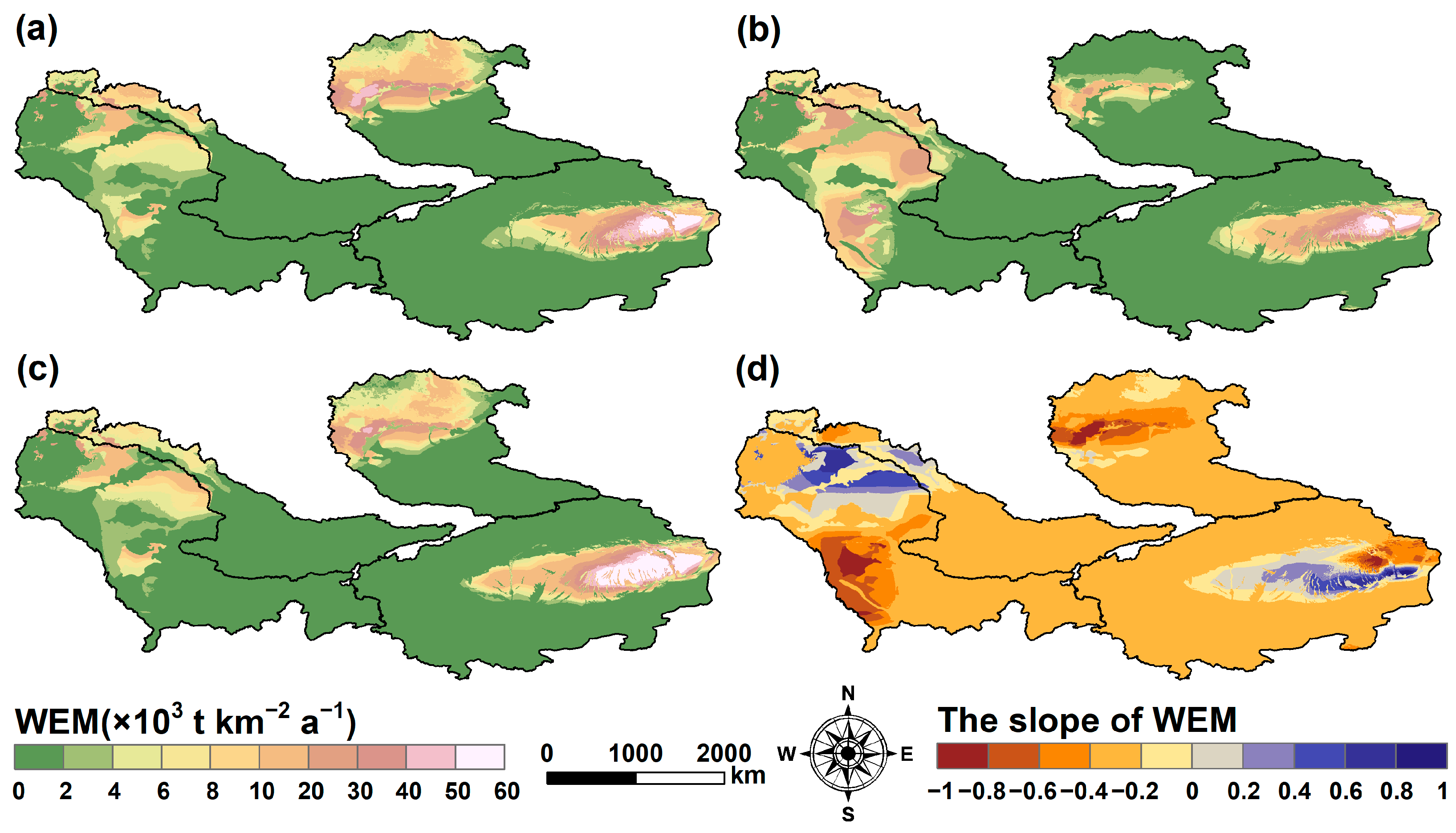
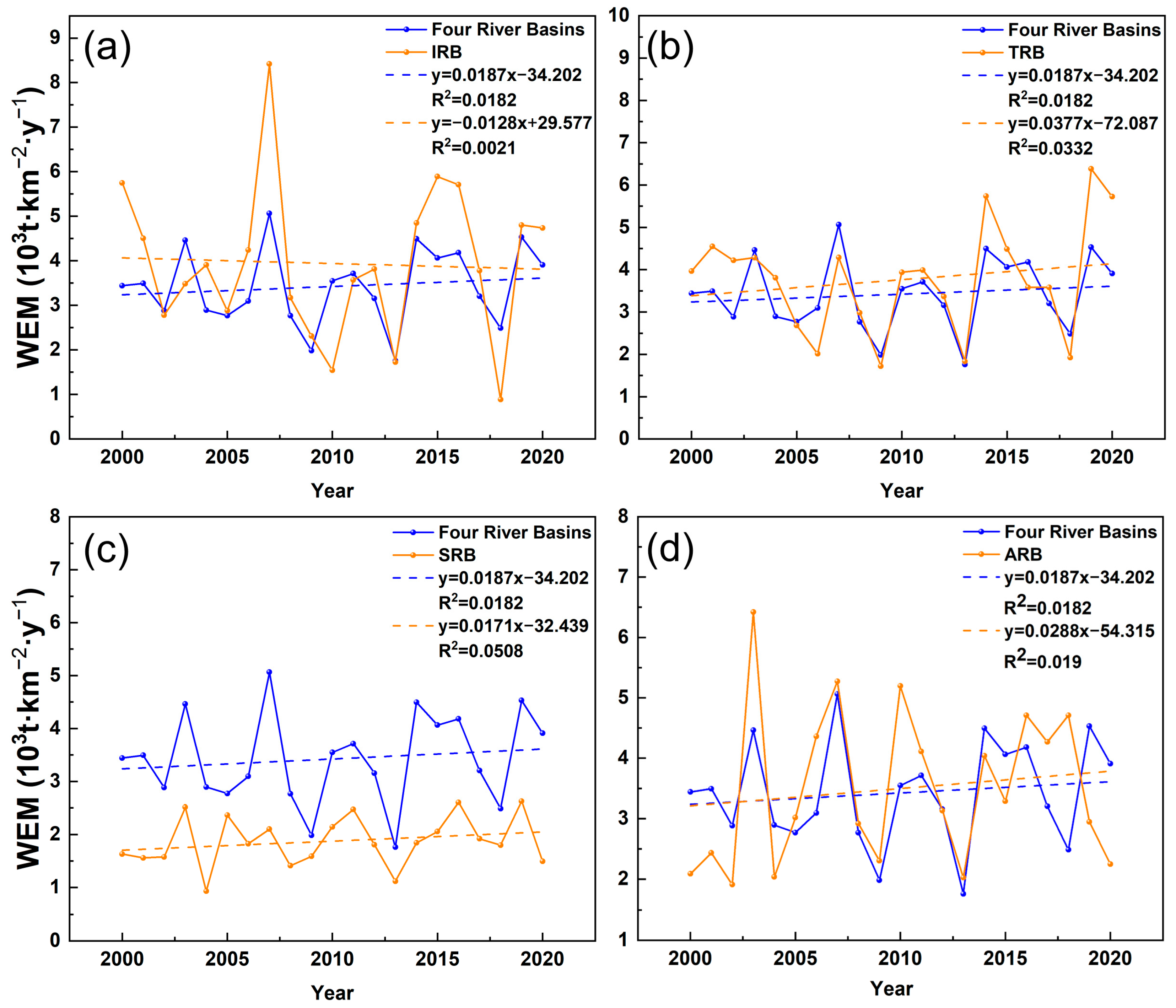

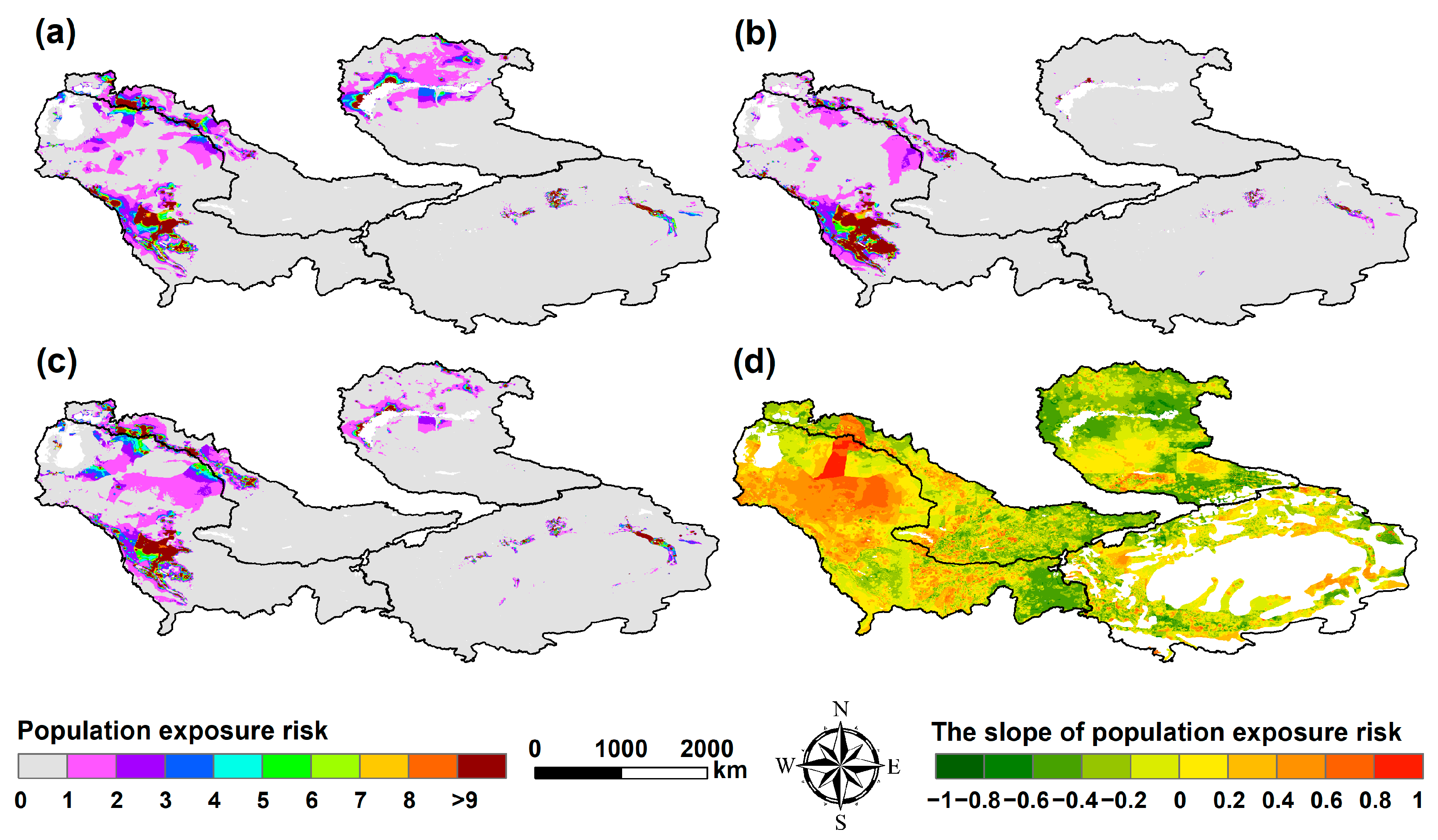
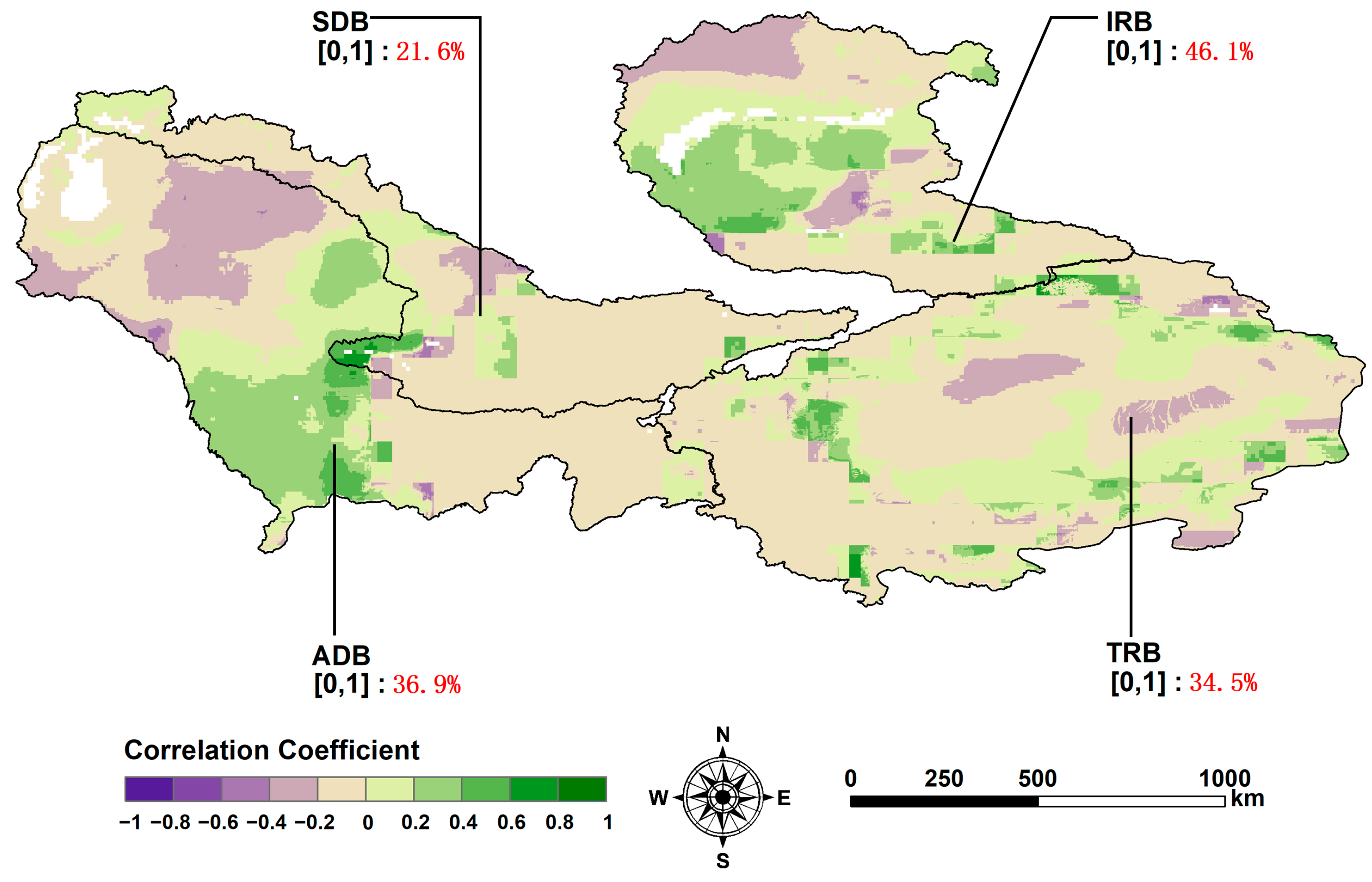

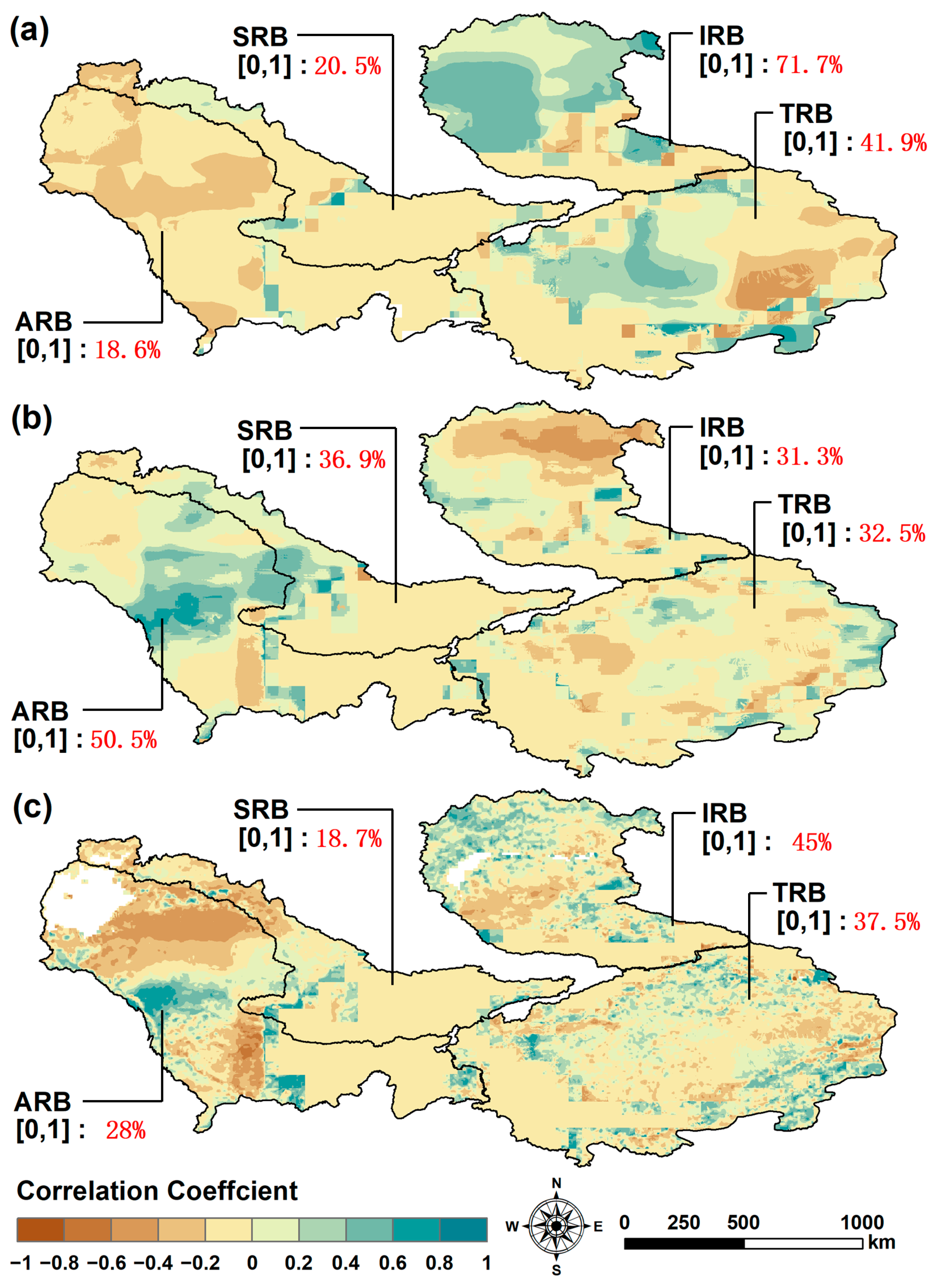
| Name | Resolution | Period | Link |
|---|---|---|---|
| Wind speed | Daily, 0.1° × 0.1° | 1982–2020 | (https://www.ecmwf.int/en/forecasts/dataset/ecmwf-reanalysis-v5 (accessed on 14 April 2023)) |
| Temperature | |||
| Precipitation | |||
| Snowfall flux | |||
| GDAS | 6 h, 0.1° × 0.1° | 2006–2020 | (https://psl.noaa.gov/data (accessed on 29 April 2023)) |
| Population grid | Annual, 1 km | 2000–2020 | (https://landscan.ornl.gov (accessed on 15 May 2023)) |
| NDVI | 16 d, 1 km | 2000–2020 | (http://ltdr.nascom.nasa.gov (accessed on 19 April 2023)) |
| Soil | N, 1 km | 2013 | (http://www.fao.org/soils-portal/en/ (accessed on 19 May 2023)) |
| LULC | Annual, 300 m | 1992–2020 | (https://www.esa-landcover-cci.org/ (accessed on 27 May 2023)) |
| PM2.5 | Monthly, 0.01° × 0.01° | 2000–2020 | (http://earthdata.nasa.gov (accessed on 16 June 2023)) |
| DEM | N, 30 m | 2019 | (https://www.rceeca.com (accessed on 28 July 2023)) |
| Year | Cropland | Forestland | Grassland | Wetland | Construction Land | Desert Land | Others |
|---|---|---|---|---|---|---|---|
| 2000 | 193.00 | 1217.47 | 2240.06 | 1019.56 | 1.04 | 7217.39 | 0.02 |
| 2010 | 350.10 | 2099.34 | 878.95 | 461.13 | 2.89 | 8465.06 | 0.07 |
| 2020 | 231.00 | 1318.08 | 2068.99 | 865.54 | 2.41 | 9022.52 | 0.02 |
| 2000–2010 variation | +157.1 | +881.87 | −1361.11 | −558.43 | +1.85 | +1247.67 | +0.05 |
| 2010–2020 variation | −119.1 | −781,26 | +1190.04 | +404.41 | −0.48 | +680.41 | −0.05 |
| 2000–2020 variation | +38.00 | +100.61 | −171.07 | −154.02 | +1.37 | +557.46 | 0.00 |
Disclaimer/Publisher’s Note: The statements, opinions and data contained in all publications are solely those of the individual author(s) and contributor(s) and not of MDPI and/or the editor(s). MDPI and/or the editor(s) disclaim responsibility for any injury to people or property resulting from any ideas, methods, instructions or products referred to in the content. |
© 2024 by the authors. Licensee MDPI, Basel, Switzerland. This article is an open access article distributed under the terms and conditions of the Creative Commons Attribution (CC BY) license (https://creativecommons.org/licenses/by/4.0/).
Share and Cite
Yu, W.; Ma, X.; Yan, W.; Wang, Y. Assessment of Soil Wind Erosion and Population Exposure Risk in Central Asia’s Terminal Lake Basins. Water 2024, 16, 1911. https://doi.org/10.3390/w16131911
Yu W, Ma X, Yan W, Wang Y. Assessment of Soil Wind Erosion and Population Exposure Risk in Central Asia’s Terminal Lake Basins. Water. 2024; 16(13):1911. https://doi.org/10.3390/w16131911
Chicago/Turabian StyleYu, Wei, Xiaofei Ma, Wei Yan, and Yonghui Wang. 2024. "Assessment of Soil Wind Erosion and Population Exposure Risk in Central Asia’s Terminal Lake Basins" Water 16, no. 13: 1911. https://doi.org/10.3390/w16131911
APA StyleYu, W., Ma, X., Yan, W., & Wang, Y. (2024). Assessment of Soil Wind Erosion and Population Exposure Risk in Central Asia’s Terminal Lake Basins. Water, 16(13), 1911. https://doi.org/10.3390/w16131911









